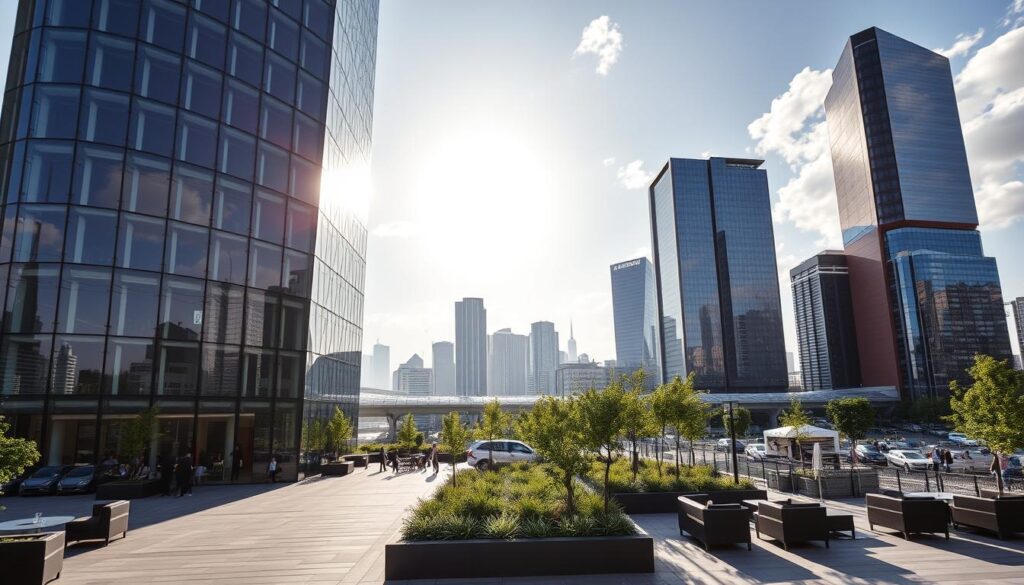Can a simple architectural element transform your outdoor space into a luxurious oasis? The answer lies in modern glass architecture, particularly in the form of a well-designed glass canopy. By incorporating a glass canopy, you can significantly enhance your outdoor area, making it an ideal spot for gatherings and relaxation.
A glass canopy not only adds a sleek, modern look to your architecture but also provides protection against the elements while allowing natural light to filter through. This makes it perfect for spaces like restaurant patios, shopping centers, and office buildings. For those looking to explore different types of glazing solutions, various structural glazing options can offer inspiration and functionality.
Key Takeaways
- Glass canopies enhance outdoor spaces by providing protection from the elements.
- They allow natural light to filter through, maintaining the aesthetic appeal.
- Glass canopies are ideal for various establishments, including restaurants and shopping centers.
- Modern glass architecture offers sleek and modern designs.
- Different types of structural glazing can be explored for unique designs.
Introduction to Structural Glass Canopies
Structural glass canopies are revolutionizing outdoor spaces with their sleek designs and advanced technology. These canopies are not just aesthetically pleasing; they also provide functional benefits, enhancing the usability of outdoor areas.
What Is a Structural Glass Canopy?
A structural glass canopy is a modern architectural feature designed to provide shelter and protection from the elements while maintaining an open feel. It is typically made from high-strength glass supported by a metal frame, creating a seamless transition between indoors and outdoors. “The integration of glass canopies into outdoor spaces has become increasingly popular due to their ability to offer unobstructed views and natural light,” as noted by architectural experts.
Benefits of Using Glass Canopies
Glass canopies offer numerous benefits, including:
- Protection from UV rays and weather elements
- Enhanced aesthetic appeal with modern designs
- Increased property value through innovative architectural features
- Flexibility in design to suit various architectural styles
The use of custom glass canopy solutions allows homeowners and architects to tailor the design to specific needs, ensuring that the canopy complements the existing structure while providing the desired functionality.
Application Areas for Glass Canopies
Glass canopies can be applied in various settings, including:
- Patios and decks, creating inviting outdoor living spaces
- Outdoor kitchens and dining areas, providing shelter without compromising on style
- Entrances and walkways, enhancing the curb appeal of buildings
- Public spaces, such as parks and transport hubs, where durability and low maintenance are key
With innovative glass canopy designs and cutting-edge glass canopy technology, the possibilities for enhancing outdoor spaces are vast. Whether for residential or commercial applications, glass canopies offer a unique blend of form and function.
Key Features of Structural Glass Canopies
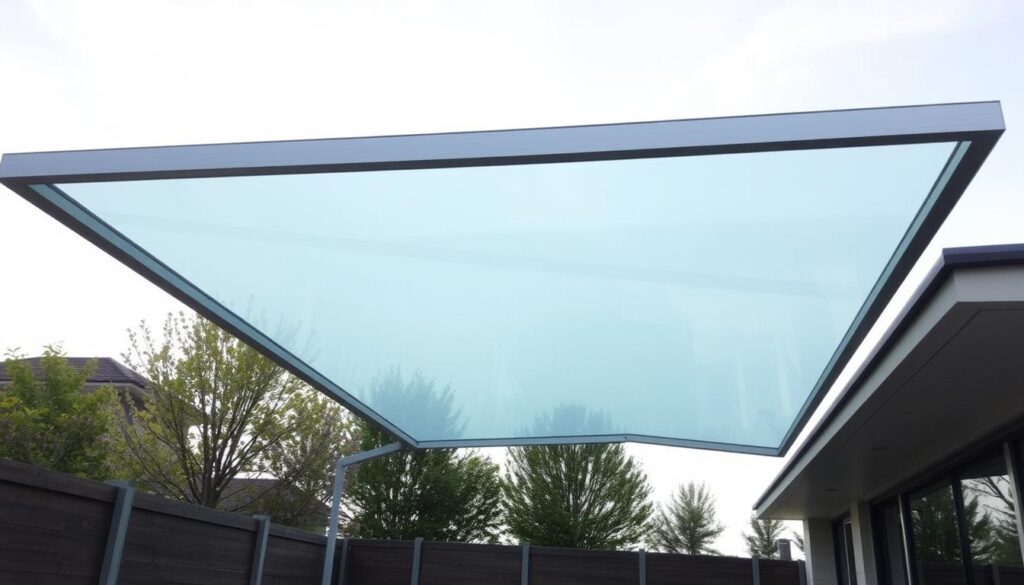
Contemporary glass canopy installations are redefining outdoor living by combining transparency with sophisticated engineering. Structural glass canopies have become a sought-after feature in modern architecture due to their unique blend of aesthetics and functionality.
Transparency and Aesthetics
One of the primary attractions of glass canopies is their ability to provide unobstructed views while allowing natural light to filter through. This transparency creates a sense of openness, making outdoor spaces feel larger and more connected to the surroundings. The aesthetic appeal of glass canopies is further enhanced by their sleek, modern design, which can be tailored to complement a variety of architectural styles.
The use of glass canopies can significantly enhance the visual appeal of a building, creating a striking feature that draws the eye and adds to the overall ambiance of the space.
Durability and Weather Resistance
Despite their sleek appearance, structural glass canopies are incredibly durable and capable of withstanding various weather conditions. The glass used in these canopies is typically laminated or tempered to enhance its strength and safety. This durability ensures that glass canopies remain a viable option for outdoor spaces, even in areas prone to harsh weather.
The weather resistance of glass canopies is a significant advantage, as it reduces the need for frequent repairs or replacements, making them a cost-effective choice in the long run.
Design Flexibility
The design flexibility offered by glass canopies is another key feature that contributes to their popularity. Whether it’s a bespoke glass canopy engineering project or a standard installation, glass canopies can be customized to fit a wide range of architectural styles and spatial configurations. This flexibility allows architects and designers to push the boundaries of creativity, incorporating glass canopies into their designs in innovative ways.
| Feature | Description | Benefit |
|---|---|---|
| Transparency | Allows natural light to filter through | Creates a sense of openness |
| Durability | Capable of withstanding various weather conditions | Reduces maintenance costs |
| Design Flexibility | Can be customized to fit various architectural styles | Enhances aesthetic appeal |
As transparent canopy design trends continue to evolve, the demand for structural glass canopies is expected to grow, driven by their unique combination of functionality, durability, and aesthetic appeal.
Materials Used in Structural Glass Canopy Design
Selecting the right materials is a critical step in the design and construction of structural glass canopies, influencing both their durability and their appearance. The choice of materials can significantly impact the overall performance, safety, and aesthetic appeal of the canopy.
Types of Glass for Canopies
The type of glass used for canopies is crucial for their strength, safety, and functionality. Common types include tempered glass and laminated glass. Tempered glass is known for its resistance to thermal stress and its ability to shatter into blunt fragments upon breakage, reducing the risk of injury. Laminated glass, on the other hand, consists of multiple layers of glass bonded together with an interlayer, providing enhanced security and sound insulation.
For more detailed information on glass canopy systems, visit Extech Inc.’s page on glass canopy, which provides insights into technical detailing for high-performance design.
Supporting Structures: Metals and Frames
The supporting structures, including metals and frames, play a vital role in holding the glass canopy in place. Materials such as aluminum, stainless steel, and timber are commonly used due to their strength, durability, and aesthetic versatility. The choice of metal or frame material can affect the canopy’s overall design, load-bearing capacity, and resistance to weathering.
| Material | Strength | Durability | Aesthetic Appeal |
|---|---|---|---|
| Aluminum | High | Corrosion-resistant | Modern, sleek |
| Stainless Steel | Very High | Highly durable | Contemporary, robust |
| Timber | Variable | Requires maintenance | Natural, warm |
Finishings and Coatings
Finishings and coatings can enhance the performance and appearance of glass canopies. Coatings can provide UV protection, reduce glare, and improve energy efficiency by controlling heat gain and loss. Additionally, various finishing techniques can be applied to the supporting structures to achieve the desired aesthetic and to protect the materials from environmental degradation.
For instance, applying a low-e coating can significantly improve the energy efficiency of a glass canopy by minimizing heat transfer. Similarly, using powder coating or anodizing for metal frames can enhance their durability and visual appeal.
Design Considerations for Glass Canopies
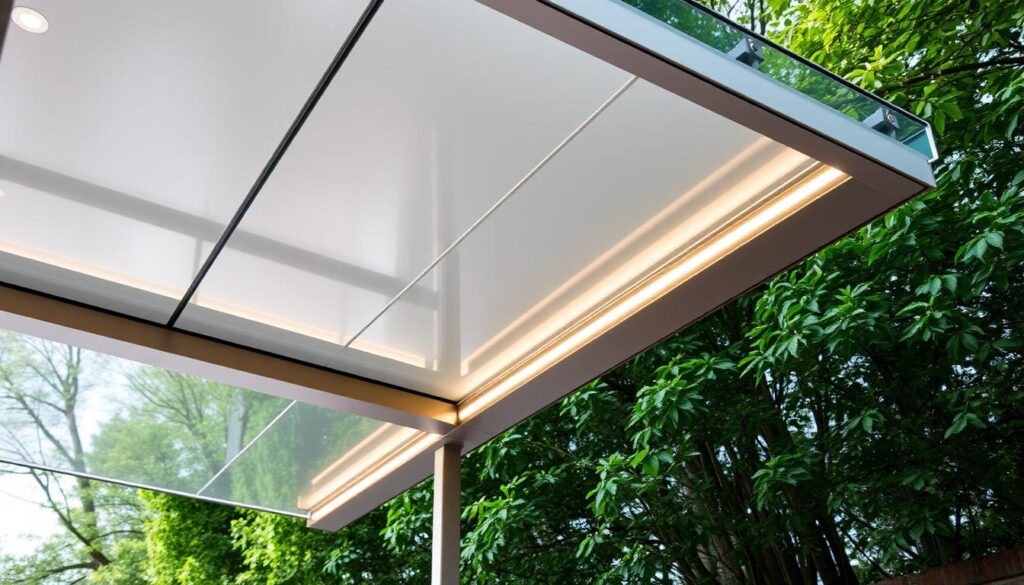
When designing a glass canopy, several critical factors must be considered to ensure both functionality and compliance with regulations. A well-designed glass canopy not only enhances the aesthetic appeal of a building but also provides protection from the elements.
Load-Bearing Capacity
One of the primary considerations in glass canopy design is load-bearing capacity. The structure must be able to support its own weight, as well as withstand external loads such as snow, wind, and potentially, the weight of maintenance personnel. For more information on choosing the right glass for your canopy, refer to this comprehensive guide.
Local Building Codes and Regulations
Compliance with local building codes and regulations is crucial. These codes dictate the minimum requirements for structural integrity, safety features, and energy efficiency. Designers must familiarize themselves with these regulations to avoid costly revisions or legal issues. This resource provides a detailed overview of structural glass design principles.
Climate Impacts on Design Choices
Climate plays a significant role in glass canopy design. Different climates impose unique challenges, such as high winds, heavy snowfall, or intense sunlight. Designers must consider these factors to select appropriate materials and design elements that will ensure the canopy’s durability and performance over time.
By carefully considering these design factors, architects and designers can create custom glass canopy solutions that are both aesthetically pleasing and functionally robust. The integration of innovative glass canopy designs can significantly enhance the overall appeal and value of a property.
Customization Options for Glass Canopies
Bespoke glass canopy engineering has opened up new possibilities for architects and homeowners, allowing for the creation of truly one-of-a-kind outdoor spaces. The ability to customize glass canopies in terms of shape, size, color, and texture has made them an increasingly popular choice for those looking to enhance their properties.
Shape and Size Variations
One of the most significant advantages of glass canopies is their versatility in terms of shape and size. Whether you’re looking to cover a small entranceway or a large outdoor living area, glass canopies can be designed to fit your specific needs. From curved to angular shapes, the design possibilities are endless, allowing for a seamless integration with existing architectural elements.
Color and Texture Choices
Glass canopies can also be customized in terms of color and texture, providing an additional layer of personalization. Various tinting options and coatings can be applied to the glass to achieve the desired aesthetic and functional properties. For instance, tinted glass can reduce glare and heat gain, while textured glass can add visual interest and create a unique ambiance.
Integration with Other Architectural Elements
The integration of glass canopies with other architectural elements is another key aspect of their customization. By combining glass canopies with features such as LED lighting, pergolas, or outdoor heating systems, it’s possible to create a cohesive and functional outdoor space that meets your specific needs and preferences.
| Customization Aspect | Description | Benefits |
|---|---|---|
| Shape and Size | Varied shapes and sizes to fit different architectural designs | Flexibility in design, seamless integration |
| Color and Texture | Options for tinting, coating, and texturing | Aesthetic customization, functional benefits (e.g., glare reduction) |
| Integration | Combining with other architectural elements like LED lighting and outdoor heating | Enhanced functionality, cohesive design |
The Role of Engineering in Canopy Design
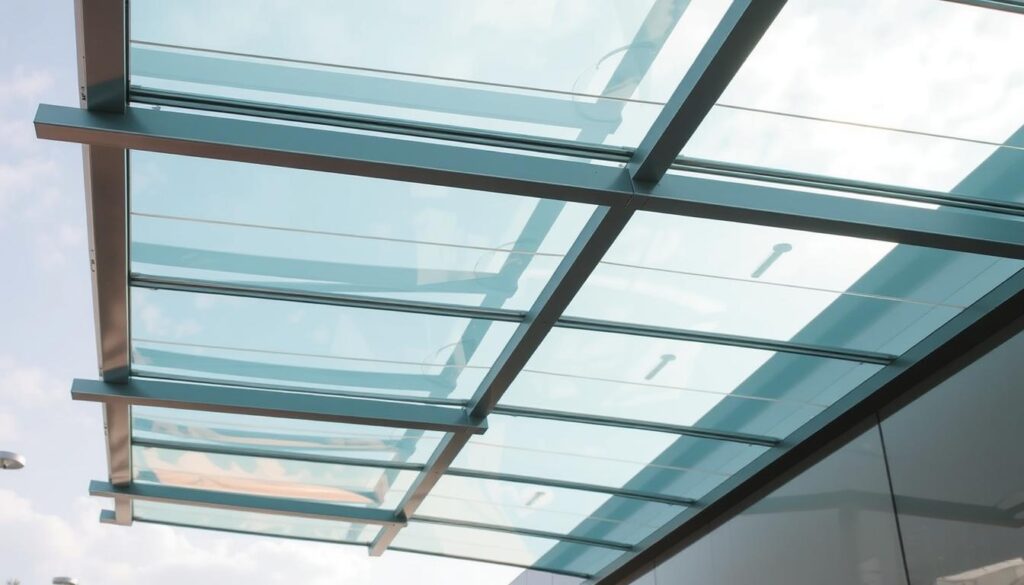
Designing a glass canopy involves more than just aesthetics; it demands robust engineering to ensure structural integrity. The process requires a deep understanding of various engineering principles to create a canopy that is both visually appealing and safe.
Structural Engineering Fundamentals
The foundation of any successful glass canopy design lies in its structural engineering. This involves calculating load-bearing capacities, understanding material strengths, and ensuring that the canopy can withstand various environmental conditions. Engineers must consider factors such as wind resistance, snow load, and seismic activity to guarantee the canopy’s durability.
For instance, the use of laminated glass can enhance the structural integrity of a canopy by providing additional strength and safety. Moreover, the frame and supporting structures must be designed to work in harmony with the glass, distributing loads effectively and maintaining the overall stability of the canopy.
Collaboration with Architects
Effective collaboration between engineers and architects is crucial in the design of glass canopies. Architects bring their expertise in aesthetics and functionality, while engineers provide the technical knowledge necessary to bring the design to life. This multidisciplinary approach ensures that the final product is both beautiful and structurally sound.
By working together, architects and engineers can identify potential issues early in the design process, making adjustments as needed to optimize the canopy’s performance. This collaboration is highlighted in projects featured on platforms like World Civil Society, where innovative designs showcase the potential of glass canopies.
Innovations in Canopy Engineering
The field of canopy engineering is continually evolving, with advancements in materials and technology driving innovation. New types of glass, such as smart glass, offer enhanced functionality, including the ability to change tint or opacity in response to environmental conditions. Additionally, improvements in framing materials and designs contribute to more efficient and sustainable canopies.
These innovations not only improve the performance and sustainability of glass canopies but also expand the possibilities for their use in various architectural contexts. As cutting-edge glass canopy technology continues to develop, we can expect to see even more creative and functional designs in the future.
Installation Process of Structural Glass Canopies
A successful structural glass canopy installation hinges on thorough preparation. This process involves several key stages, from initial preparations to the final installation and subsequent maintenance.
Pre-Installation Preparations
Before the actual installation begins, several preparatory steps are crucial. These include:
- Conducting a thorough site analysis to determine the optimal placement and design of the canopy.
- Ensuring that the site is accessible for the installation team and their equipment.
- Reviewing and complying with local building codes and regulations.
Site analysis is critical as it helps in identifying potential challenges such as uneven terrain or environmental factors that could impact the installation.
Steps for a Successful Installation
The installation process itself involves several precise steps:
- Preparing the foundation or mounting points for the canopy.
- Assembling the canopy structure, which includes the frame and the glass panels.
- Securing the canopy in place, ensuring it is level and properly aligned.
Innovative glass canopy designs often require customized installation techniques. It’s essential to work with experienced professionals who can handle these unique requirements.
Post-Installation Care and Maintenance
After the installation is complete, regular maintenance is necessary to ensure the longevity and appearance of the glass canopy. This includes:
- Regular cleaning to prevent dirt buildup.
- Inspecting the canopy for any signs of damage or wear.
- Addressing any issues promptly to prevent them from becoming major problems.
By following these steps and working with professionals who specialize in custom glass canopy solutions, property owners can enjoy their glass canopies for years to come.
Cost Factors Influencing Glass Canopy Design

Several factors contribute to the overall cost of a bespoke glass canopy engineering project. Understanding these elements is crucial for designing a glass canopy that meets both functional and budgetary requirements.
Material Costs
The choice of materials significantly impacts the total cost. High-quality glass, for instance, can be more expensive but offers better durability and aesthetic appeal. The type of glass used, such as laminated or tempered glass, also affects the cost.
Supporting structures and frames made from metals like aluminum or steel vary in price based on their strength, finish, and complexity. The cost of these materials can fluctuate with market prices for metals.
Labor and Installation Expenses
Labor costs are another significant factor. The complexity of the design and the size of the canopy influence the number of hours required for installation. Experienced contractors with expertise in transparent canopy design trends may charge more, but their work ensures a high-quality finish and structural integrity.
Installation expenses also include the cost of equipment and scaffolding necessary for the job. In some cases, specialized equipment may be required, adding to the overall expense.
“The cost of labor and materials can vary widely depending on the project’s location and the local market conditions.” – Industry Expert
Long-Term Value Considerations
While initial costs are important, it’s equally crucial to consider the long-term value of the glass canopy. A well-designed canopy can increase property value and reduce maintenance costs over time.
Energy efficiency is another long-term consideration. Modern glass canopies can be designed to maximize natural light, potentially reducing the need for artificial lighting and thus saving energy costs.
By balancing initial costs with long-term benefits, homeowners and businesses can make informed decisions about their glass canopy projects.
Environmental Impact of Glass Canopies
The environmental implications of glass canopies are a complex issue, intertwining sustainability, energy efficiency, and design innovation. As architects and builders increasingly adopt glass canopies in modern glass architecture, understanding their ecological footprint becomes crucial.
Sustainability in Material Choices
Glass canopies are often praised for their use of sustainable materials. Glass itself is 100% recyclable, making it a highly sustainable choice for architectural glass structures. Moreover, advancements in manufacturing processes have reduced the environmental impact of glass production. For instance, many manufacturers now use recycled glass in their products, further decreasing the ecological footprint. As noted by experts, “the use of recycled materials in glass production can significantly reduce energy consumption and lower emissions” sustainable building materials.
The supporting structures for glass canopies, often made from metals like aluminum or steel, can also be sourced from recycled materials, enhancing the overall sustainability of the structure. It’s essential to consider the lifecycle of these materials, from production to disposal or recycling, to fully understand their environmental impact.
Energy Efficiency Features
Glass canopies can significantly contribute to energy efficiency in buildings. By allowing natural light to penetrate deeper into the building, the need for artificial lighting is reduced, thereby lowering energy consumption. Modern glass canopies can be designed with energy-efficient glass that minimizes heat transfer, keeping buildings cooler in the summer and warmer in the winter. This not only enhances the comfort of occupants but also reduces the demand on heating and cooling systems.
Energy-efficient design practices in glass canopies include the use of double or triple glazing, low-e coatings, and gas fills between panes to improve thermal performance. These features can significantly reduce a building’s carbon footprint, making glass canopies a valuable component of eco-friendly design practices.
Eco-Friendly Design Practices
Eco-friendly design practices play a crucial role in minimizing the environmental impact of glass canopies. This includes designing canopies that maximize natural ventilation, reducing the need for mechanical cooling and heating systems. Additionally, incorporating shading devices or smart glass technologies can further enhance energy efficiency by controlling the amount of solar radiation that enters the building.
“The integration of smart technologies and sustainable materials in glass canopy design represents a significant step forward in reducing the environmental impact of modern architecture.”
By embracing sustainability in material choices, energy efficiency features, and eco-friendly design practices, architects and builders can create glass canopies that not only enhance the aesthetic appeal of buildings but also contribute to a more sustainable future.
Popular Trends in Structural Glass Canopy Design
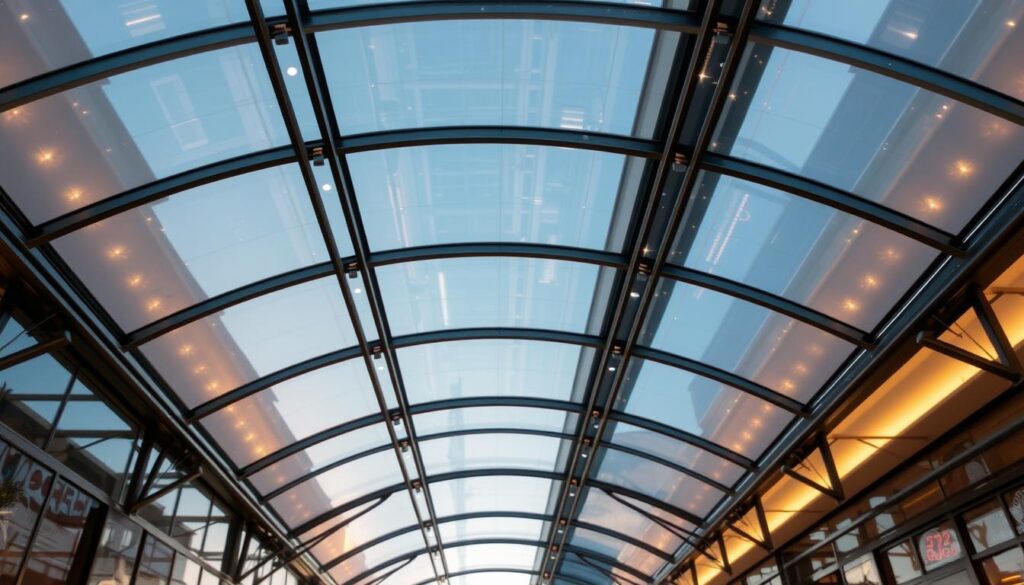
Innovative glass canopy designs are redefining outdoor spaces, offering a blend of style, durability, and technology. As homeowners and architects look for ways to enhance the aesthetic and functional appeal of buildings, the demand for cutting-edge glass canopy technology is on the rise.
Minimalist Design Approaches
Minimalist design has become a significant trend in structural glass canopy design. Characterized by simplicity and clean lines, minimalist glass canopies provide a sleek, modern look that complements contemporary architecture. The use of frameless glass systems and subtle supporting structures enhances the sense of openness and transparency.
According to a recent architectural survey, “Minimalism in design is not just about simplicity; it’s about creating a sense of calm and clarity in the built environment.”
“The beauty of minimalist design lies in its ability to balance form and function, creating spaces that are both visually appealing and highly functional.”
Biophilic Design Elements
Biophilic design, which incorporates elements of nature into the built environment, is another trend gaining traction in glass canopy design. By integrating natural materials, patterns, and light, biophilic glass canopies create a connection between indoor and outdoor spaces, promoting well-being and sustainability.
A notable example of biophilic design is the use of glass canopies with integrated greenery or natural textures, which not only adds visual interest but also contributes to a more eco-friendly building envelope. For more information on glass canopy designs, visit Fab Glass and Mirror.
Smart Technology Integration
The integration of smart technology into glass canopies represents a significant advancement in the field. Smart glass canopies can adjust their tint or transparency in response to environmental conditions, optimizing energy efficiency and occupant comfort. This technology not only enhances the functionality of glass canopies but also contributes to a more sustainable built environment.
| Trend | Description | Benefits |
|---|---|---|
| Minimalist Design | Simple, frameless glass systems | Aesthetic appeal, openness |
| Biophilic Design | Incorporation of natural elements | Sustainability, well-being |
| Smart Technology | Adaptive tinting and transparency | Energy efficiency, comfort |
Case Studies of Successful Glass Canopy Projects
The application of glass canopies in different contexts highlights their adaptability and the value they add to architectural designs. As a testament to their versatility, glass canopies have been successfully integrated into various environments, enhancing both the aesthetic appeal and functionality of spaces.
Commercial Spaces: Retail and Hospitality
In commercial settings, such as retail stores and hospitality venues, glass canopies serve as a striking architectural feature that attracts customers. For instance, a boutique hotel in downtown Manhattan incorporated a custom glass canopy solution above its entrance, creating a welcoming ambiance that sets the tone for the luxurious experience within. Similarly, a high-end retail store in Los Angeles utilized a contemporary glass canopy installation to provide a sleek, modern look that complements its storefront design.
These installations not only enhance the visual appeal of the establishments but also provide protection from the elements, ensuring a comfortable experience for visitors. According to a hospitality industry expert, “The use of glass canopies has become a trend in our industry, as it offers a unique blend of form and function that elevates the overall guest experience.”
“Glass canopies have revolutionized the way we design our outdoor spaces, offering a seamless transition between indoors and outdoors.” –
Residential Applications and Outdoor Living
In residential settings, glass canopies have become a sought-after feature for homeowners looking to enhance their outdoor living areas. By providing shade and protection from the elements, glass canopies enable homeowners to enjoy their outdoor spaces throughout the year. A residential project in California featured a custom glass canopy that not only added a touch of elegance to the home’s exterior but also created a cozy, sheltered area for outdoor dining and relaxation.
- Enhances outdoor living spaces
- Provides protection from the elements
- Adds aesthetic value to the property
Public Installations: Parks and Transport Hubs
Glass canopies have also been successfully implemented in public spaces, such as parks and transportation hubs, to provide shelter and enhance the user experience. For example, a major transportation hub in Europe incorporated a large glass canopy to cover its main concourse, creating a bright, airy atmosphere that improves the traveler’s experience. Similarly, a public park in Australia featured a glass canopy as part of its recreational facilities, offering a shaded area for visitors to enjoy.
These public installations demonstrate the potential of glass canopies to transform public spaces, making them more inviting and functional. As noted by a urban planning expert, “The strategic use of glass canopies in public spaces can significantly enhance the quality of urban environments.”
Maintenance Tips for Glass Canopies
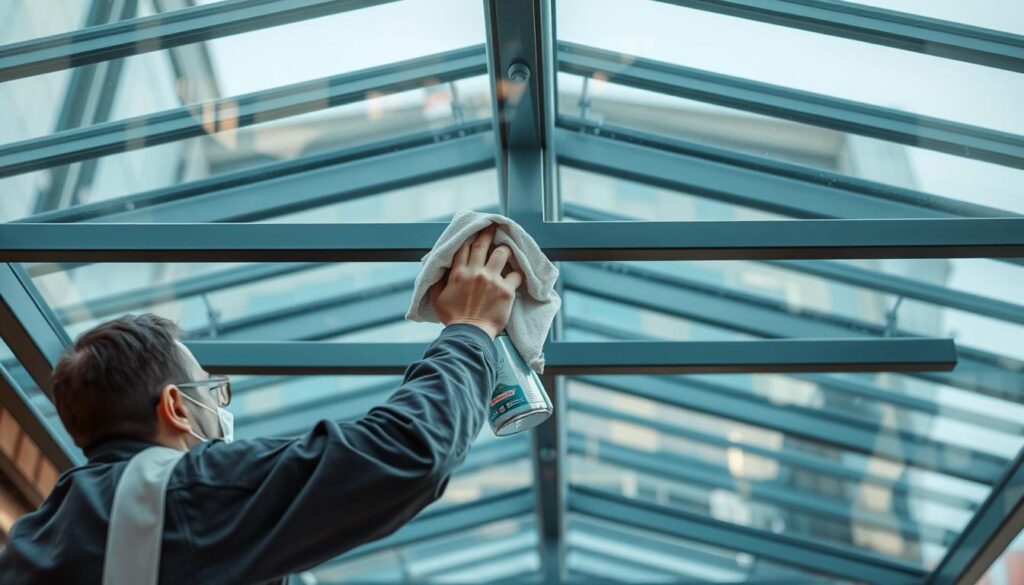
The longevity of a bespoke glass canopy engineering project depends on proper maintenance. Regular upkeep not only ensures the structural integrity of the canopy but also maintains its aesthetic appeal, aligning with the latest transparent canopy design trends.
Routine Cleaning Procedures
Cleaning is a crucial aspect of glass canopy maintenance. Use a mild detergent mixed with water and a soft, lint-free cloth to wipe down the glass surfaces. Avoid using abrasive materials or harsh chemicals that could damage the glass or its frame.
For more thorough cleaning, consider using a solution specifically designed for glass. This can help remove stubborn stains or mineral deposits, ensuring the canopy remains clear and visually appealing.
Inspections and Repairs
Regular inspections are vital to identify any potential issues before they become major problems. Check the canopy’s frame for signs of wear or damage, and inspect the glass for any chips or cracks.
If you notice any damage, it’s essential to address it promptly. For minor issues, such as small chips, a professional can often perform repairs. However, significant damage may require replacing the affected glass panel.
Addressing Common Problems
One common issue with glass canopies is water accumulation, which can lead to staining or structural problems. Ensure that the canopy’s drainage system is functioning correctly and clear of debris.
Another issue is dirt or debris accumulation on the glass surface, which can obstruct visibility and affect the canopy’s appearance. Regular cleaning, as described earlier, can mitigate this problem.
By following these maintenance tips, you can extend the life of your glass canopy and keep it looking its best, in line with the principles of bespoke glass canopy engineering and current design trends.
Future Outlook for Structural Glass Canopy Design
The future of structural glass canopy design is poised to revolutionize outdoor spaces with cutting-edge modern glass architecture. As technology advances, we can expect to see innovative glass canopy designs that not only enhance aesthetic appeal but also improve functionality.
Advancements in Glass Technology
Emerging technologies in glass design are set to play a significant role in shaping the future of architectural glass structures. New manufacturing processes and materials are being developed to create stronger, more durable glass that can withstand various environmental conditions.
Trends in Outdoor Spaces
Trends shaping the future of outdoor spaces include a focus on sustainability and energy efficiency. Glass canopies are being designed to maximize natural light and reduce the need for artificial lighting, contributing to more eco-friendly buildings.
Urban Planning and Glass Canopies
The role of glass canopies in urban planning is becoming increasingly important. They are being used to create inviting public spaces and enhance the urban landscape. As cities continue to evolve, we can expect to see more innovative glass canopy designs that transform urban environments.
